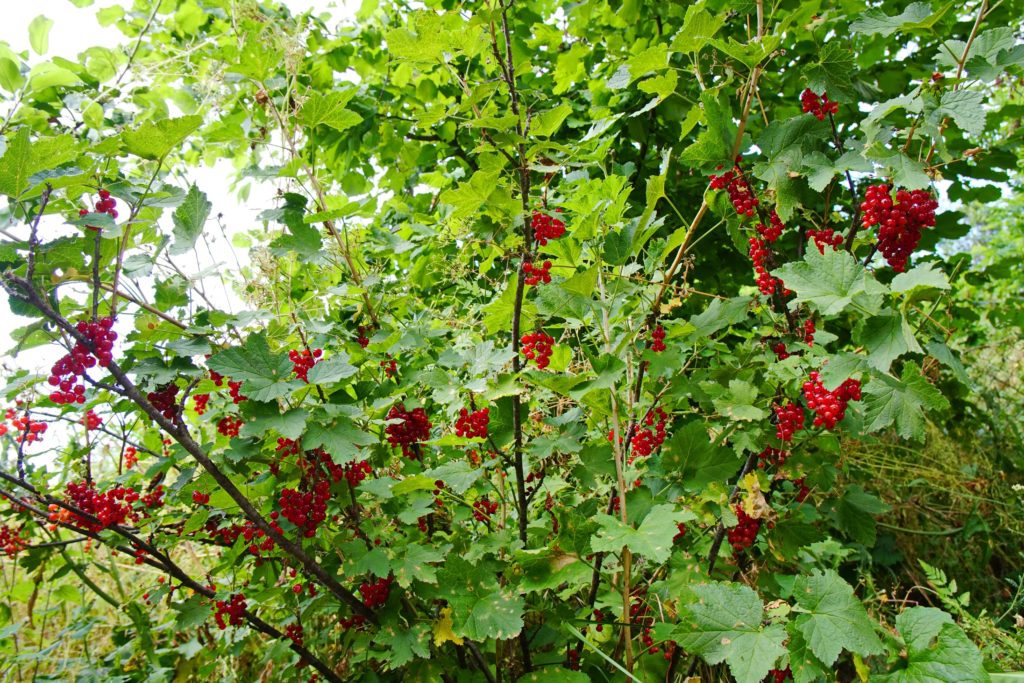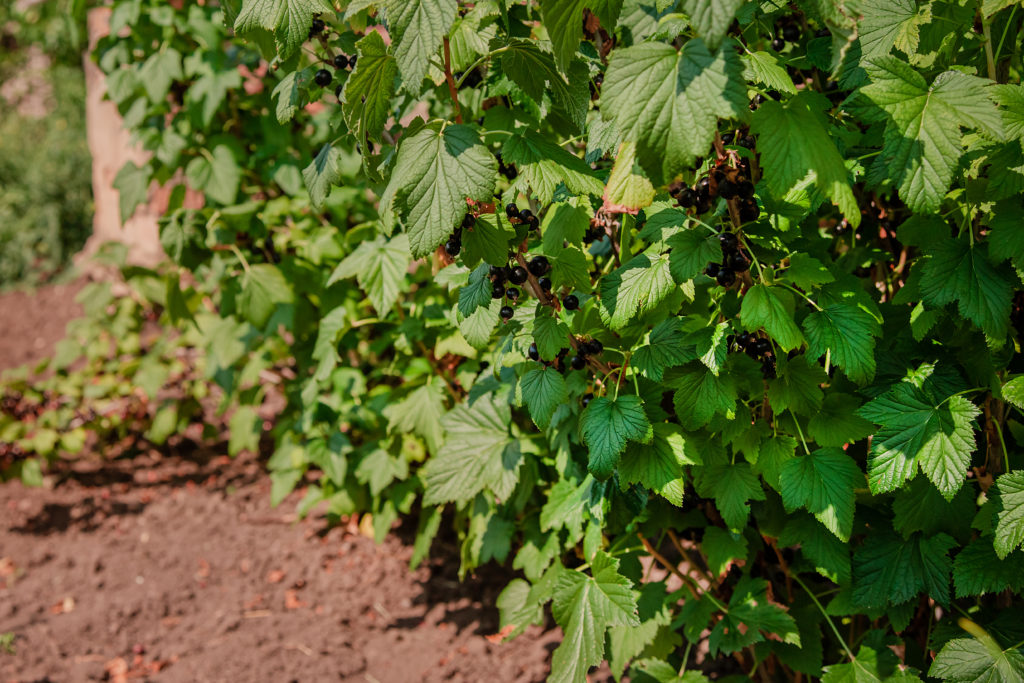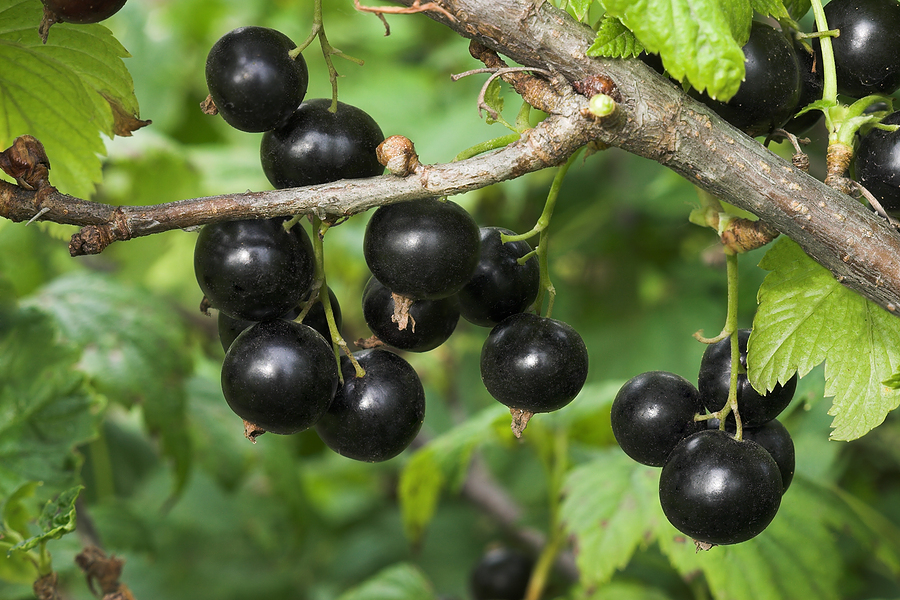Currants are small, round berry-like fruits that can be eaten fresh or cooked with sugar and made into pie fillings, puddings, dessert sauces, jams, and jellies.
There are red, white–actually yellowish-white, and black-fruited currants. Currants grow as bushes to about 6 feet tall. They grow best in cool-summer regions and seldom thrive in warm-summer regions unless planted in a cool shady spot. Currants are deciduous; they lose their leaves in winter.
Red and white currants grow on a small stem or trunk often referred to as a “leg’’; black currants grow from multiple stems that sprout from the soil. Black currants have different pruning requirements than red and white currants. Apart from pruning, red, white, and black currants have the same growing and care requirements.
Here is your complete guide to growing currants.
Best climate and site for growing currants
- Currants grow best in cool summer climates.
- Plant currants in full sun. In hot regions, grow currants in partial shade. Grown in partial shade currants will take longer to ripen and may not be as sweet as those grown in full sun. Where summers are hot plant currants against a north-facing wall, north-facing slope, or in partial shade.
- Plant currants in a sheltered spot away from a prevailing breeze or wind. Do not plant currants in low spots where frost can settle.
- Plant currants in slightly acidic soil to neutral soil; a soil pH of 6.5 to 7.0 is optimal. Currants will grow in average garden soil.
- Do not plant currants in waterlogged soil.
- Add aged compost or commercial organic planting mix to planting beds; currants grow best in well-drained soil.

Choosing the right currant plant
- Red, white, pink, and black currants can be eaten fresh or cooked.
- Red and white currants have a tart, acidic flavor. Of the two, the white currant is sweeter. (White currants are actually a creamy yellow or faint pink color.) The red currant is tart and acidic flavored. Red and white currants can be eaten raw or cooked.
- Black currants are sweet and can be eaten straight from the bush or cooked and made into jams, jellies, and juices.
- Currants can be purchased bare-root or container-grown. Choose certified disease-free plants.
- Plant bare-root currants in spring. Container-grown plants can be planted from spring through autumn; autumn is the ideal planting time for container-grown currants.
- Currants have a bush form and can grow to 6 feet tall.
- Black currants have the botanical name Ribes nigrum. Red currants and white currants have the botanical name Ribes uva-crispa.
How to plant currants
- Plant bare-root currants in spring as soon as the soil can be worked or in fall. Currants leaf out in spring; it’s best to plant currants before they leaf out.
- Plant container-grown currants in spring or summer; avoid planting them in hot dry weather.
- Red and white currants grow on a short stem or “leg” from which lateral branches or stems spread out. The stem or leg should be free of side shoots to 4 to 6 inches high. A standard bush can have a leg 2 to 3 feet tall.
- Black currants do not grow on a leg. Multiple black currant stems emerge directly from the ground instead of branching out from a single trunk.
- Dig a hole half again as deep at the root ball and twice as wide; moisten the hole before planting. Make a small mound at the bottom of the hole and spread out the roots of the plant so that they run off the mound.
- Plant red and white currants so that the soil mark of the nursery pot is level with the soil of the new planting hole.
- Plant black currants so that the soil marks on the stems will sit 2 inches below the surface of the soil. The stems of black currants emerge directly from the soil instead of branching out from a single trunk-like red and white currants.
- Backfill the hole with half-native soil and half-aged compost or commercial organic planting mix. Firm in the soil to be sure no air pockets remain around the roots.
- Cut back the stems of bare-root black currants to about 1 inch above the soil level; only two buds should remain on each stem. Do this to encourage strong root growth. Container-grown black currants with a substantial root system do not need to be cut back.
- Water the new plant with a high phosphorus liquid starter fertilizer.
- Keep the soil evenly moist as the plant begins to grow.
Spacing currants
- Space red and white currant bushes 5 feet apart. Space black currants 6 feet apart.
- Space rows of red and white currants 5 feet apart. Space rows of black currants 6 feet apart.
- Red and white currants trained to a single leader or stem grown on stakes can be spaced 18 inches apart.
Currant yield and how many to plant
- One currant bush—red, white, or black–will yield about 10 pounds of currants each year.
- A red or white currant plant grown on a stake or cordon will yield about 2 pounds each year.
Currant pollination
- Currants are self-pollinating. New buds and flowers form at the base of last year’s stems.
Container growing currants
- Plant currants in pots 12 to 18 inches wide and deep or wider; currant roots do not grow deep. Currant roots do not mind growing in a tight space. Plant currants in an organic potting mix.
- Keep the soil evenly moist; feed plants an all-purpose fertilizer.
- Re-pot currants every three years after harvest; trim roots as necessary to avoid becoming root-bound. Renew the soil when repotting.

Watering and feeding currants
- Keep currants well-watered; do not let the soil dry out; irregular watering can cause currant skins to crack as they develop or near harvest. Do not splash water on foliage; wet foliage is susceptible to fungal diseases.
- Feed currants an all-purpose fertilizer in spring; a fertilizer slightly higher in potassium is recommended. During the growing season side-dress currants with a dilute solution of fish emulsion.
- Avoid high-nitrogen fertilizers; nitrogen will increase green growth at the expense of fruit growth.
Currant care
- Currants are hardy but it’s still a good idea to protect new spring foliage, buds, and flowers from frost by placing row covers over the plants.
- Keep currant planting beds free of weeds; mulch planting beds with aged compost or commercial organic planting mix to keep down weeds.
- Protect currants from birds that will eat the buds in late winter and spring and the fruit in summer; place bird netting over plants to exclude birds.
- Protect new flower buds and flowers from frost in spring; if frost threatens cover budding or flowering plants with a floating row cover.
How to prune red and white currants
- During the first two years, prune red and white currants to create an open, vase-like structure. An open structure will allow sunlight and air to reach the interior of the plant and ripen fruit.
- In the first year, select 3 or 4 main stems that grow away from the leader (main stem) in opposite directions. Cut each back by half. Remove other smaller branches and stems as well as those that are broken or crossing. Create an open vase-like form, an open center. When pruning stems, cut just above an outward-facing bud; new branches will grow outward, not inward.
- The second year select 3 or 4 more stems growing away from the leader and allow these to grow on while again pruning away stems that are growing inward. By the third summer, you will have 9 to 12 sturdy stems growing out from the leader or main stem; these will be your main flowering and fruiting stems.
- The third year going forward, prune back about half of the previous year’s growth on each outward growing stem and continue to prune away new stems growing inwards; also prune away suckers growing from the base of the plant. During the summer prune, all new side shoots so that there is just one bud on each stem.
- At the end of each season of the first three seasons keep 3 or 4 of the best shoots. In the fourth year, remove the stems from the first year, the oldest stems, and keep 3 to 4 of the best new young stems; each following year trim away the oldest wood and renew the plant by selecting the best of the new stems.
- Currants fruit on older wood; to keep currants productive, cut back young stems and side shoots.
How to prune black currants
- The stems of bare-root black currants (with multiple stems emerging from the soil) should be cut back to about 1 inch above the ground after planting. This will encourage strong root growth.
- The stems of container-grown black currants that have established roots do not need to be cut back after planting.
- The second winter after planting, prune new stems that are weak or growing parallel to the ground.
- Established black currants can be pruned much like gooseberries. Keep the interior of the bush free of weak, broken, diseased, or crossing stems. Also, trim away stems drooping close to the ground. Each year after the third year, cut away 3-year-old wood to make way for younger fruiting wood. (Older stems will be dark-colored; newer one- and two-year-old stems will be paler and fruit-bearing; these should not be removed unless they are damaged.)
How to train currants
- Red and white currants can be trained as a standard, cordon, or fan.
- Train the leader upward and tie it in at one-foot intervals. Prune side shoots in summer so that they have just 5 leaves; in winter prune side shoots so that there is one bud facing outwards. This will generate new fruiting spurs.
Currant pests
- Leaves that are eaten may be a sign of caterpillars. Control imported currant worm (sawfly larvae) with a rotenone/pyrethrin mix; control currant borer by cutting off the stem just below the borer entry hole.
- Curled or twisted leaves may be a sign of aphids; check the undersides of leaves and knock aphids off plants with a steady stream of water.
Currant diseases
- Currants—particularly black currants–can be a host to blister rust, a disease that can seriously affect white pine trees. If white pines grow in your regions, check with the nearby Cooperative Extension Service to see if planting currants is controlled.
- Powdery mildew and leaf spot can attack currants; spray the foliage with a fungicide or a solution of 1-part baking soda and 9-part water.
- Leaves that brown or dieback may be attacked by the fungus botrytis; trim dieback off immediately.
- Orange or red blisters on leaves can be a sign of the fungal disease rust. Trim away these leaves and spray the plant with a fungicide or compost tea.
- Gray or brown mold on fruit is a sign of botrytis or another fungal disease; this can also cause leaf dieback. Remove affected fruit and prune to encourage greater air circulation.
Currant environmental problems
- Leaves with brown curled edges that look scorched yellow can be a sign of potassium deficiency in the soil.
- Leaves that turn yellow between the veins (called chlorosis) can be a sign of a manganese or iron deficiency.
- Cracked skin on currants can be a sign of irregular watering or birds attacking. Keep the soil evenly moist and exclude birds with netting.
Currant propagation
- Red and white currants can be propagated by hardwood cuttings and tip layering. Black currants can be propagated by hardwood cuttings, tip layering, and mound layering.
- Hardwood cutting propagation: take a hardwood cutting in the fall; strip the cutting of all but the newest leaves and root in an organic potting mix; rooting can take up to a year.
- Tip layering propagation: bend a low-hanging shoot with at least 3 buds to the ground in mid-summer and hold it in place with a garden staple or rock. Cover the stem with soil; the shoot will root in a year’s time and the new plant can be cut away from the parent.
- Mound layering propagation: cut back all branches to 3 inches after growth starts in spring and then cover the stubs with soil; new shoots will appear and take root; they can be cut away from the mother plant and replanted as new plants.

Harvesting currants
- Harvest currants when they taste sweet. Red currants will turn bright scarlet when ripe; taste white currants to determine when they are ripe. Ripe black currants will be shiny blue-black.
- Fruit on an individual plant commonly does not ripen all at once; you will likely have to revisit plants to harvest again. Generally, the fruit at the top of the truss (called “strig”) ripens first. Some recent cultivars have been bred to ripen fruit simultaneously. Taste to determine ripeness if in doubt.
- Ripe currants can be eaten raw. Less ripe or firm fruits can be used for cooking or preserving.
- The first crop will come the second season after planting.
- Currants for cooking and making jelly should be harvested slightly underripe (they contain more pectin at that stage); unripe currants retain some acidity.
- Currants for fresh eating or desserts should be allowed to ripen fully on the bush.
- Currants develop full flavor only when they are left to ripen on the bush. Ripe currants will be full-colored.
- The harvest of one plant will last five to six weeks.
How to store currants
- Keep harvested berries out of direct sunlight.
- Currants will keep in the refrigerator for only a few days. Currants can be frozen for later use.
Fall and winter currant care
- Feed currants a moderate amount of nitrogen and a high amount of potassium and magnesium in late winter.
- Thin currant stems and branches in winter if not done sooner. See pruning instructions above.
Currant varieties to grow
- Red currants are perhaps the most popular; varieties include ‘Red Lake’, ‘Minnesota 71’, ‘Perfection’, ‘Wilder’, ‘Red Cross’, ‘Fay’, ‘Red Lake’, ‘Stanza’, ‘Rovada’, ‘Jonkheer van Tets’, ‘Junifer’. Highly productive varieties include ‘Red Lake’, ‘Perfection’, ‘Wilder’.
- White currants varieties include ‘White Grace’, ‘White Imperial’, ‘White Versailles’, ‘Blanka’.
- Black currant varieties include ‘Ebony’, ‘Ben Lomond’, ‘Ben Sarek’, ‘Big Ben’, ‘Ben Connan’, ‘Baldwin’, ‘Titania’. Black currant plants and fruit can sometimes have an unpleasant odor.
Related articles:
Planning the Home Fruit Garden
Garden Planning Books at Amazon:
- Vegetable Garden Almanac & Planner
- Kitchen Garden Grower’s Guide Vegetable Encyclopedia
- Vegetable Garden Grower’s Guide
- Tomato Grower’s Answer Book
More fruit-growing articles:
Learn how to plant, grow, prune, and harvest your favorite fruits. Click below for all you need to know.
- Apple
- Apricot
- Avocado
- Banana
- Blackberry
- Blueberry
- Cantaloupe
- Chayote
- Cherimoya
- Cherry
- Citrus
- Clementine
- Cranberry
- Currants
- Elderberry
- Feijoa
- Fig
- Gooseberry
- Grape
- Grapefruit
- Guava
- Kiwifruit
- Kumquat
- Lemon
- Lime
- Loquat
- Mandarin
- Mango
- Melon
- Mulberry
- Muskmelon
- Nectarine
- Olive
- Orange
- Papaya
- Passion Fruit
- Peach
- Pear
- Persimmon
- Pineapple
- Pineapple Guava
- Plantain
- Plum
- Pomegranate
- Pumpkin
- Quince
- Raspberry
- Strawberry
- Tangelo
- Tangerine
- Tangor
- Watermelon















